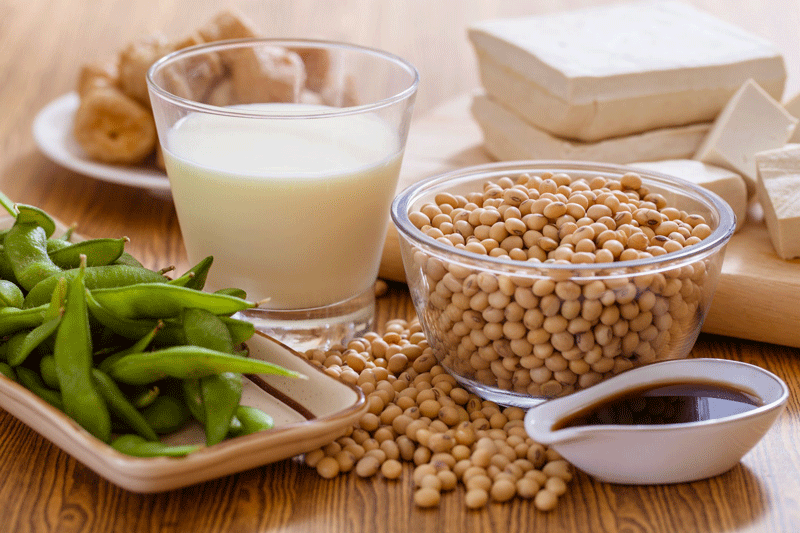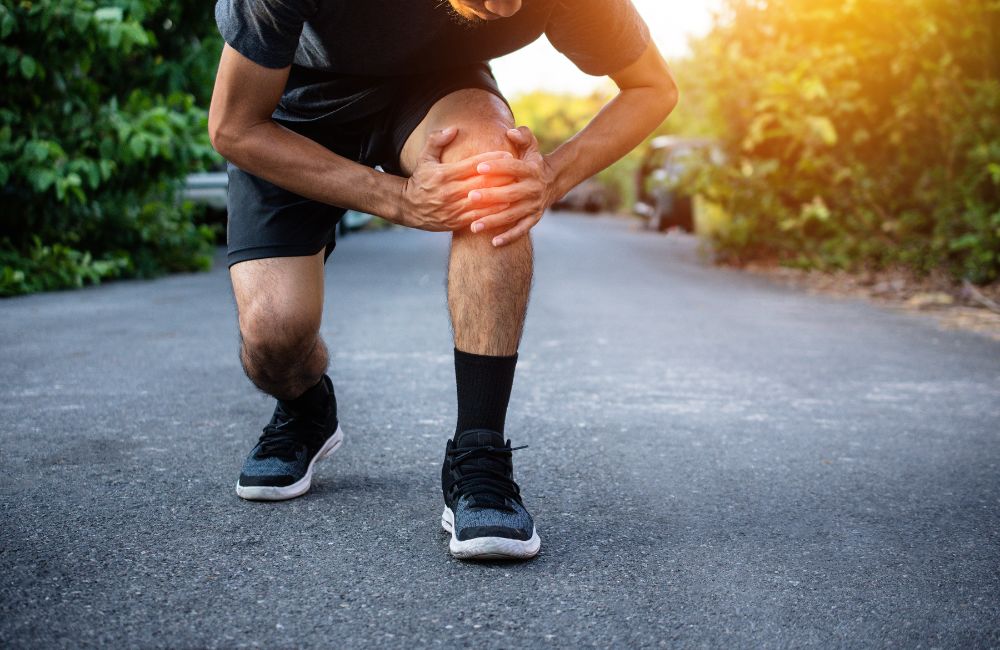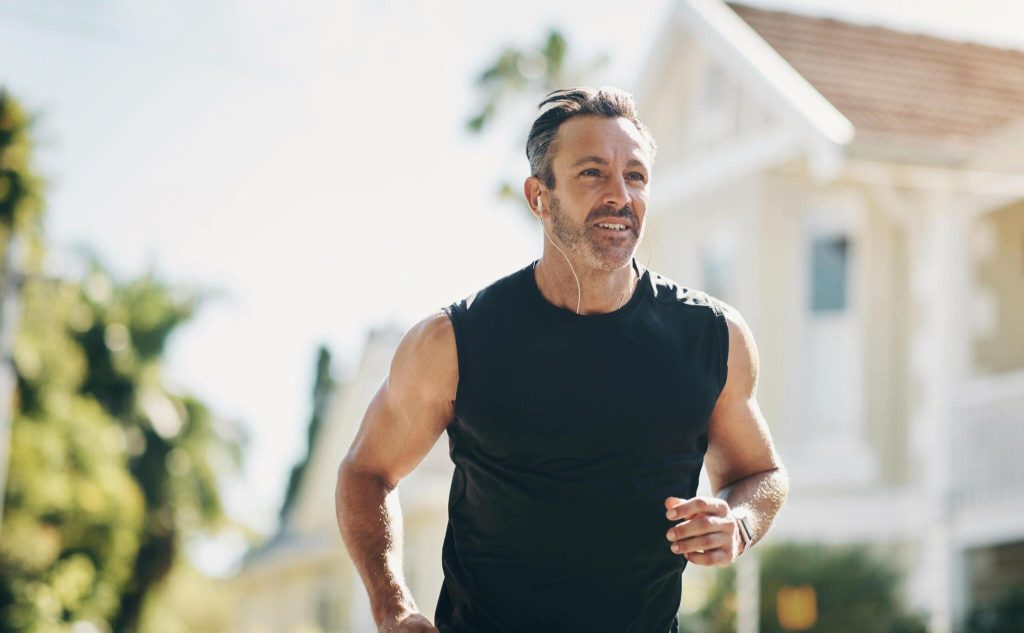Estrogen Replacement Therapy (ERT) is a medical treatment used to alleviate symptoms associated with menopause, such as hot flashes, mood swings, and osteoporosis. While ERT can be highly effective, its success can be further enhanced by a supportive diet. Certain foods can naturally boost estrogen levels and improve overall health, making the therapy more effective. Here, we will highlight the top eight foods that support estrogen replacement therapy and provide practical tips on how to incorporate them into your diet.
How Diet Influences Estrogen Replacement Therapy
Diet plays a crucial role in hormone regulation, including estrogen levels. Certain foods contain phytoestrogens, plant-based compounds that mimic the function of estrogen in the body. These compounds can help balance hormone levels, making estrogen replacement therapy more effective. Additionally, a diet rich in antioxidants, fiber, and healthy fats can reduce inflammation and support overall hormonal health.
A diet that supports estrogen replacement therapy offers several benefits, including enhanced effectiveness of the therapy, improved overall health, and reduced risk of chronic diseases. By consuming foods rich in phytoestrogens, vitamins, and minerals, individuals can experience fewer side effects and better results from their ERT.
- Enhanced Therapy Effectiveness: Consuming foods that support hormone balance can make estrogen replacement therapy more effective, leading to better management of menopausal symptoms.
- Improved Overall Health: A diet rich in nutrients supports overall health, reducing the risk of chronic diseases such as heart disease, diabetes, and osteoporosis.
- Reduced Side Effects: By supporting hormonal balance and reducing inflammation, a supportive diet can help minimize the side effects associated with estrogen replacement therapy.
8 Foods That Support Estrogen Replacement Therapy
Incorporating these specific foods into your diet can significantly enhance the effectiveness of estrogen replacement therapy, helping to balance hormone levels and improve overall health.
1. Flaxseeds
Flaxseeds are an excellent source of lignans, which are phytoestrogens, as well as omega-3 fatty acids, fiber, and various vitamins and minerals.
- Lignans: Promote hormonal balance, enhance gut health by acting as prebiotics, and may reduce the risk of certain cancers.
- Omega-3 Fatty Acids: Essential for reducing inflammation and supporting heart health. Omega-3s also provide energy for your body and play vital roles in supporting your heart, blood vessels, lungs, immune system, and endocrine system.
- Fiber: Promotes gut health, reduces the risk of developing type 2 diabetes, and supports healthy bowel function.
- Vitamins and Minerals: Flaxseeds are also rich in magnesium, manganese, and vitamin B1.
Benefits for ERT
- Hormone Balance: Can stabilize estrogen levels, which is crucial for the success of estrogen replacement therapy.
- Reduced Menopausal Symptoms: Regular consumption of flaxseeds can lead to fewer and less severe hot flashes and night sweats.
- Improved Heart Health: Omega-3 fatty acids support cardiovascular health, which is particularly important during menopause.
How to Incorporate Flaxseeds into Your Diet
- Smoothies: Add a tablespoon of ground flaxseeds to your morning smoothie for a nutritional boost. This is an easy way to incorporate flaxseeds into your daily routine without altering the taste of your smoothie.
- Salads: Sprinkle flaxseeds on salads for added crunch and nutrition. You can also mix them into salad dressings.
- Baked Goods: Incorporate flaxseeds into bread, muffins, and cookies. Flaxseeds can be used as an egg substitute in baking by mixing one tablespoon of ground flaxseeds with three tablespoons of water.

2. Soy Products
Soy products, such as tofu, tempeh, soy milk, and edamame, are rich in isoflavones, a type of phytoestrogen. They also provide protein, fiber, and essential vitamins and minerals.
- Isoflavones: Support bone health by reducing bone loss and improving bone density, which is particularly beneficial during menopause.
- Protein: Soy products are a great source of plant-based protein, which is essential for muscle maintenance and overall health.
- Fiber: Supports digestive health and helps regulate blood sugar levels.
- Vitamins and Minerals: Soy products are rich in calcium, iron, and B vitamins.
Benefits for ERT
- Hormone Balance: Isoflavones help stabilize estrogen levels, enhancing the effectiveness of estrogen replacement therapy in CT.
- Reduced Menopausal Symptoms: Soy consumption can lead to fewer hot flashes and improved overall comfort during menopause.
- Bone Health: Soy products are high in calcium and vitamin D, which are essential for maintaining strong bones.
Types of Soy Products
- Tofu: Versatile and can be used in savory and sweet dishes. Tofu can be grilled, baked, or added to soups and stir-fries.
- Tempeh: Fermented soy product with a firm texture, perfect for stir-fries. Tempeh can be marinated and grilled or crumbled into dishes as a meat substitute.
- Soy Milk: Great alternative to dairy milk, can be used in cereals, coffee, and smoothies. Soy milk is available in various flavors, including vanilla and chocolate.
- Edamame: Young soybeans that can be eaten as a snack or added to salads and soups. Edamame can be steamed and seasoned with a bit of salt for a healthy snack.
3. Sesame Seeds
Sesame seeds are rich in lignans, calcium, magnesium, and healthy fats.
- Lignans: Provide antioxidant properties, reduce inflammation, and support cardiovascular health.
- Calcium and Magnesium: Essential minerals that support bone health and overall wellness.
- Healthy Fats: Omega-6 fatty acids are crucial for hormone production and reducing inflammation.
- Vitamins: Sesame seeds are also a good source of B vitamins and vitamin E.
Benefits for ERT
- Antioxidant Support: Sesame seeds provide antioxidants that reduce oxidative stress, which can enhance overall health and support the effectiveness of estrogen replacement therapy.
- Bone Health: High levels of calcium and magnesium support bone strength, reducing the risk of osteoporosis.
- Heart Health: Healthy fats in sesame seeds support cardiovascular health, which is important during menopause.
How to Incorporate Sesame Seeds into Your Diet
- Salads: Sprinkle sesame seeds on salads for added texture and nutrition. Their nutty flavor complements many salad ingredients.
- Dressings: Use sesame seeds in homemade dressings and sauces. You can blend sesame seeds with olive oil, vinegar, and herbs for a delicious dressing.
- Snacks: Eat sesame seeds as part of trail mix or sprinkle them on yogurt. Sesame seeds can also be used in baking to add a crunchy topping to bread and muffins.
4. Chickpeas
Chickpeas, also known as garbanzo beans, are rich in fiber, protein, and phytoestrogens.
- Phytoestrogens: These compounds provide antioxidant benefits, protecting cells from damage and reducing inflammation.
- Protein: Essential for muscle maintenance and overall health.
- Vitamins and Minerals: Chickpeas are rich in folate, iron, and other essential nutrients.
Benefits for ERT
- Hormone Balance: Phytoestrogens assist in balancing hormone production, improving mood stability and reducing hormone-related disruptions.
- Digestive Health: High fiber content supports healthy digestion and regular bowel movements.
- Blood Sugar Regulation: Fiber helps maintain steady blood sugar levels, reducing the risk of insulin resistance.
Recipes and Uses
- Hummus: Blend chickpeas with tahini, lemon juice, and garlic for a healthy dip. Hummus can be used as a spread for sandwiches or as a dip for vegetables.
- Salads: Add chickpeas to salads for extra protein and fiber. Chickpeas pair well with a variety of vegetables and dressings.
- Soups: Use chickpeas in soups and stews for a hearty and nutritious meal. They add texture and nutritional value to any soup.

5. Berries
Berries, including blueberries, strawberries, raspberries, and blackberries, are packed with antioxidants, vitamins, and fiber.
- Antioxidants: Help combat oxidative stress and reduce inflammation.
- Fiber: Enhances nutrient absorption, stabilizes energy levels throughout the day, and helps reduce inflammation in the digestive tract.
- Vitamins: High in vitamin C, K, and other essential nutrients.
- Low in Calories: Berries are a low-calorie food, making them a healthy snack option.
Benefits for ERT
- Reduced Inflammation: Antioxidants help combat inflammation, which can interfere with hormone balance.
- Hormonal Health: Regular consumption of berries supports overall hormone health and enhances the effectiveness of estrogen replacement therapy.
- Heart Health: High levels of antioxidants and fiber support cardiovascular health.
Types of Berries
- Blueberries: High in antioxidants and can be eaten fresh or frozen. Blueberries can be added to smoothies, yogurt, and baked goods.
- Strawberries: Rich in vitamin C and perfect for smoothies and desserts. Strawberries can be eaten fresh, sliced on cereals, or used in salads.
- Raspberries: High in fiber and great for adding to yogurt and oatmeal. Raspberries are also a delicious addition to smoothies and desserts.
- Blackberries: Packed with vitamins and perfect for snacking or adding to salads. Blackberries can be eaten fresh or used in baking.
6. Leafy Greens
Leafy greens such as spinach, kale, collard greens, and arugula are rich in vitamins, minerals, and fiber.
- Vitamins: High in vitamins A, K, C, and folate.
- Minerals: Rich in calcium, iron, and magnesium.
- Low in Calories: Leafy greens are low in calories, making them a nutritious and filling food.
Benefits for ERT
- Nutrient-Dense: Leafy greens are packed with essential vitamins and minerals that support overall health.
- Hormonal Health: Regular consumption of leafy greens can help balance hormone levels and enhance the effectiveness of estrogen replacement therapy in CT.
- Bone Health: High levels of calcium and vitamin K support bone strength and reduce the risk of osteoporosis.
Popular Choices
- Spinach: Versatile and can be used in salads, smoothies, and cooked dishes. Spinach is rich in iron and can be added to a variety of meals.
- Kale: Nutrient-dense and great for salads, soups, and smoothies. Kale can be eaten raw or cooked and is high in vitamins A, C, and K.
- Collard Greens: Rich in calcium and perfect for sautéing or adding to stews. Collard greens have a slightly bitter taste and are often used in southern cooking.
- Arugula: Peppery flavor, great for salads and as a topping for pizzas. Arugula adds a spicy kick to dishes and is high in vitamins A and C.
7. Nuts
Nuts such as almonds, walnuts, pistachios, and cashews are excellent sources of healthy fats, protein, and phytoestrogens.
- Phytoestrogens: Support cardiovascular health by improving cholesterol levels and reducing the risk of heart disease.
- Healthy Fats: Essential for hormone production and reducing inflammation.
- Protein: Supports enzyme and hormone production, promotes satiety and weight management, and contributes to strong bones.
- Fiber: Enhances digestive health, supports heart health by lowering cholesterol, and helps in maintaining a healthy weight.
Benefits for ERT
- Hormone Balance: Natural compounds in certain foods help harmonize estrogen levels, enhancing the body’s hormonal balance and effectiveness of hormone therapies.
- Heart Health: Healthy fats in nuts support cardiovascular health, which is important during menopause.
- Inflammation Reduction: Nuts help reduce inflammation, supporting overall health.
Types of Nuts
- Almonds: High in vitamin E and perfect for snacking or adding to dishes. Almonds can be eaten raw, roasted, or used in baking.
- Walnuts: Rich in omega-3 fatty acids and great for salads and baking. Walnuts can be added to oatmeal, yogurt, and desserts.
- Pistachios: High in protein and fiber, great for snacking. Pistachios can be eaten on their own or added to dishes for extra crunch.
- Cashews: Creamy texture, perfect for making nut butter or adding to stir-fries. Cashews can be used in both sweet and savory dishes.
8. Whole Grains
Whole grains such as oats, quinoa, barley, and brown rice are high in fiber, vitamins, and phytoestrogens.
- Fiber: Aids in weight management by increasing satiety, helps prevent constipation, and supports a healthy microbiome.
- Phytoestrogens: May alleviate menopausal symptoms, such as hot flashes and mood swings, by mimicking natural estrogen in the body.
- Protein: Enhances metabolic function, assists in cell growth and regeneration, and improves endurance and strength.
- Vitamins and Minerals: Whole grains are rich in B vitamins, iron, and magnesium.
Benefits for ERT
- Hormone Balance: Phytoestrogens aid in maintaining optimal hormone levels, reducing the severity of menopausal symptoms and supporting overall hormonal health.
- Digestive Health: High fiber content supports healthy digestion and regular bowel movements.
- Blood Sugar Regulation: Fiber helps maintain steady blood sugar levels, reducing the risk of insulin resistance.
Best Whole Grains
- Oats: Versatile and can be used in oatmeal, granola, and baking. Oats are rich in beta-glucan, which supports heart health.
- Quinoa: High in protein and perfect for salads, bowls, and side dishes. Quinoa is a complete protein, providing all essential amino acids.
- Barley: Great for soups, stews, and salads. Barley is high in soluble fiber, which helps lower cholesterol levels.
- Brown Rice: Nutritious alternative to white rice, perfect for any meal. Brown rice is rich in fiber and B vitamins.
Tips for Integrating These Foods into Your Diet
To make the most of the benefits from these estrogen-supporting foods, here are some practical tips for easily incorporating them into your daily meals.
Meal Planning and Preparation
- Plan Ahead: Create a weekly meal plan that includes these estrogen-supporting foods. Planning meals in advance ensures you have all the ingredients you need and helps you stay on track with healthy eating.
- Batch Cooking: Prepare large batches of meals and snacks to save time and ensure you have healthy options available. Batch cooking allows you to prepare meals in advance, making it easier to incorporate these foods into your diet.
- Experiment with Recipes: Try new recipes and cooking methods to keep your meals interesting and enjoyable. Exploring different cuisines and cooking styles can help you discover new ways to enjoy these foods.
Balanced Diet Approach
- Variety is Key: Incorporate a variety of these foods into your diet to ensure you get a range of nutrients. Eating a diverse range of foods helps you obtain all the essential nutrients your body needs.
- Combine with Other Nutrient-Dense Foods: Pair these estrogen-supporting foods with other healthy options, such as lean proteins, fruits, and vegetables. A balanced diet that includes a wide variety of nutrient-dense foods supports overall health and enhances the effectiveness of estrogen replacement therapy.
- Listen to Your Body: Pay attention to how your body responds to different foods and adjust your diet as needed. Everyone’s body is different, so it’s important to find what works best for you.
Consistency is Key
- Regular Consumption: Make these foods a regular part of your diet to maximize their benefits for estrogen replacement therapy. Consistent consumption of these foods helps maintain stable hormone levels and supports overall health.
- Stay Hydrated: Drink plenty of water throughout the day to support overall health and hormone balance. Staying hydrated is essential for maintaining healthy bodily functions and supporting hormone metabolism.
- Monitor Progress: Keep track of your symptoms and overall health to see how these dietary changes are affecting your estrogen replacement therapy. Monitoring your progress can help you identify what works best for you and make adjustments as needed.
Frequently Asked Questions
Can I fix my estrogen naturally?
Yes, you can support your estrogen levels naturally by incorporating foods rich in phytoestrogens, such as flaxseeds, soy products, and sesame seeds, into your diet. Additionally, maintaining a healthy lifestyle with regular exercise, adequate sleep, and stress management can help balance your hormones.
How to know if estrogen is low?
Low estrogen levels can manifest through various symptoms, including hot flashes, night sweats, irregular menstrual cycles, mood swings, and vaginal dryness. A healthcare provider can confirm low estrogen through a blood test and provide appropriate treatment options.
What age is too late for estrogen?
There is no definitive age that is “too late” for estrogen therapy, but it is generally most effective and safe when started around the time of menopause. Starting estrogen replacement therapy more than 10 years after menopause may increase certain health risks.
Does estrogen age you?
Estrogen can have anti-aging effects, particularly on the skin, by maintaining its elasticity and moisture. Low estrogen levels during menopause can lead to signs of aging such as wrinkles and sagging skin. Estrogen replacement therapy can help mitigate these effects, but it should be used under medical supervision.
Can estrogen reverse sagging skin?
Estrogen can improve skin elasticity and hydration, which may help reduce the appearance of sagging skin. While it may not completely reverse sagging skin, estrogen replacement therapy can enhance skin quality and slow down further sagging.
Take Action for Better Health Today!
If you’re ready to enhance your estrogen replacement therapy with a supportive diet and professional guidance, consider consulting with BioRestore. Located conveniently for residents across CT, BioRestore offers personalized hormone therapy plans tailored to your unique needs.
Don’t wait—we can help you start your journey towards balanced hormones and improved well-being. Contact BioRestore in CT today to schedule your consultation and take the first step towards a healthier, happier you.

Hormone therapy for men is a medical treatment aimed at addressing hormonal imbalances that can affect overall health, energy levels, mood, and physical fitness. This therapy is often used to treat conditions such as low testosterone, which can lead to symptoms like fatigue, depression, and reduced muscle mass. After age 30, testosterone levels begin to gradually decline, and chronic health conditions like obesity and type 2 diabetes can exacerbate this decline. While hormone therapy for men can be highly effective, combining it with an appropriate exercise regimen can significantly enhance its benefits.
How Exercise Influences Hormone Levels
Exercise plays a crucial role in regulating and boosting hormone levels in the body. Physical activity, especially resistance training and high-intensity workouts, can increase the production of testosterone and other beneficial hormones. For instance:
- Resistance Training: Men who engaged in regular resistance training experienced significant increases in testosterone levels compared to those who did not exercise. This increase in testosterone is vital for men undergoing hormone therapy, as it can amplify the therapy’s effects, leading to better overall health outcomes.
- Insulin Sensitivity: Exercise enhances insulin sensitivity, which is crucial for maintaining balanced hormone levels. Improved insulin sensitivity helps regulate blood sugar levels, reducing the risk of conditions like diabetes, which can negatively impact hormonal health.
- Cortisol Levels: Physical activity can reduce cortisol levels, a stress hormone that, when elevated, can interfere with testosterone production. By incorporating regular exercise into your routine, you can create a more favorable hormonal environment in your body, complementing the effects of hormone therapy for men.
Benefits of Combining Exercise with Hormone Therapy
Combining exercise with hormone therapy for men offers numerous benefits. Physical activity can enhance mood by increasing the production of endorphins, often referred to as “feel-good” hormones. Moreover, regular exercise boosts energy levels, helping men feel more invigorated and capable of handling daily tasks with ease. Key benefits include:
- Improved Mood: Exercise increases the production of endorphins, helping to alleviate symptoms of depression and anxiety.
- Increased Energy Levels: Regular physical activity boosts energy, making it easier to manage daily activities.
- Enhanced Muscle Growth: Exercise promotes muscle growth and strength, which is particularly beneficial for men undergoing hormone therapy. Testosterone is a key hormone for muscle development, and combining hormone therapy with strength training can lead to significant improvements in muscle mass and overall physical fitness.
- Better Cardiovascular Health: Cardiovascular exercises improve heart health and circulation, supporting the body’s ability to deliver oxygen and nutrients to tissues, including muscles.
- Weight Management: Hormonal imbalances can lead to weight gain, particularly around the abdomen. Regular physical activity helps burn calories and maintain a healthy weight, which in turn supports better hormone balance.
- Improved Sleep Quality: Exercise can improve sleep quality, which is essential for overall health and hormonal regulation. Better sleep patterns contribute to more stable hormone levels, enhancing the effectiveness of hormone therapy for men.
12 Exercises That Support Hormone Therapy for Men
Incorporating the right exercises into your routine can significantly enhance the effectiveness of hormone therapy for men. These exercises not only help in boosting testosterone levels but also improve overall physical fitness, mental well-being, and quality of life. Here are 12 exercises that support hormone therapy for men, providing detailed explanations, benefits, and tips for each.
Exercise 1: Weight Lifting
Weight lifting is one of the most effective exercises for supporting hormone therapy for men. It involves lifting weights to build muscle mass and strength. Studies have shown that weight lifting can significantly increase testosterone levels and improve overall physical fitness.
Benefits
- Testosterone Boost: Stimulates testosterone production, crucial for muscle growth and overall health.
- Muscle Mass: Helps build and maintain muscle mass, essential for physical fitness and metabolic health.
- Strength: Improves overall body strength, making daily tasks easier and reducing the risk of injuries.
Recommended Frequency and Duration
- Aim for Consistency: Lift weights at least three times per week to see progress.
- Focus on Compound Movements: Incorporate squats, deadlifts, bench presses, and rows for maximum muscle engagement.
- Repetition Range: Perform 3-4 sets of 8-12 repetitions for each exercise.
Proper Forms
- Maintain Proper Form: Keep your back straight and core engaged throughout each exercise.
- Gradual Progression: Start with lighter weights and increase gradually to avoid strain or injury.
- Seek Professional Guidance: Consider working with a trainer to learn correct form and technique.
Exercise 2: Squats
Squats are a powerful exercise for building lower body strength and boosting testosterone levels. This compound movement targets the quadriceps, hamstrings, glutes, and core muscles.
Benefits of Squats for Hormone Levels
- Testosterone and Growth Hormone: Stimulates the release of growth hormone and testosterone, essential for muscle growth and overall health.
- Lower Body Strength: Improves strength and stability in the legs and core, enhancing overall physical fitness.
- Functional Fitness: Mimics everyday movements, improving your ability to perform daily tasks.
Proper Form and Variations
- Form: Stand with feet shoulder-width apart, toes slightly turned out. Lower your body by bending your knees and hips, keeping your back straight. Push through your heels to return to the starting position.
- Variations: Goblet squats, front squats, split squats.
Exercise 3: Deadlifts
Deadlifts are another essential exercise for supporting hormone therapy for men. This full-body movement targets the back, glutes, hamstrings, and core muscles.
Benefits
- Full-Body Strength: Improves strength in the back, legs, and core, enhancing overall physical fitness.
- Functional Fitness: Mimics everyday movements, improving your ability to perform daily tasks.
Safety Tips
- Start Light: Begin with a light weight and gradually increase as you build strength.
- Form: Keep your back straight and engage your core throughout the movement. Avoid rounding your back to prevent injury.
- Progression: Consider working with a trainer to ensure proper form and technique.
Exercise 4: Push-Ups
Push-ups are a versatile upper body exercise that can be performed anywhere. They target the chest, shoulders, triceps, and core muscles.
Benefits
- Upper Body Strength: Helps increase strength in the chest, shoulders, and triceps.
- Muscle Mass: Supports muscle growth and maintenance, essential for overall physical fitness.
- Versatility: Can be modified to suit different fitness levels and performed anywhere.
Variations
- Standard Push-Ups: Basic push-up form with hands shoulder-width apart.
- Wide-Grip Push-Ups: Hands placed wider than shoulder-width apart to target the chest.
- Close-Grip Push-Ups: Hands placed close together to target the triceps.
- Incline Push-Ups: Hands elevated on a surface to reduce intensity.
Exercise 5: Pull-Ups
Pull-ups are an effective exercise for building upper body strength and supporting hormone therapy for men. They target the back, shoulders, and arms.
Benefits
- Upper Body Strength: Helps increase strength in the back, shoulders, and arms.
- Muscle Mass: Supports muscle growth and maintenance, essential for overall physical fitness.
- Endurance: Improves upper body endurance and overall physical performance.
Modifications
- Assisted Pull-Ups: Use a resistance band or machine to reduce the amount of body weight lifted.
- Negative Pull-Ups: Focus on the lowering phase of the pull-up to build strength.
- Chin-Ups: Perform with palms facing towards you to target different muscles.
Exercise 6: Cycling
Cycling is an excellent cardiovascular exercise that supports hormone therapy for men by improving heart health and increasing cardiovascular fitness.
Benefits
- Cardiovascular Health: Improves heart health and reduces the risk of cardiovascular disease.
- Stress Reduction: Lowers cortisol levels, which can negatively impact testosterone production.
- Weight Management: Helps burn calories and maintain a healthy weight, supporting better hormonal balance.
Tips for Incorporating Cycling
- Frequency: Aim to cycle for at least 30 minutes, three times per week.
- Variety: Vary your routes and intensity to keep your workouts engaging.
- Safety: Ensure your bike is properly maintained and wear appropriate safety gear.

Exercise 7: Running
Running is a popular cardio exercise that offers numerous benefits for hormone therapy for men. It helps improve cardiovascular health, reduce stress, and support weight management.
Benefits
- Cardiovascular Health: Improves heart health and reduces the risk of cardiovascular disease.
- Stress Reduction: Lowers cortisol levels, which can negatively impact testosterone production.
- Endurance: Improves overall endurance and cardiovascular fitness.
Training Tips for Beginners
- Start Slowly: Begin with short, manageable distances and gradually increase your mileage.
- Interval Training: Incorporate interval training to improve speed and endurance.
- Proper Footwear: Invest in good-quality running shoes to prevent injuries.
Exercise 8: Swimming
Swimming is a full-body workout that supports hormone therapy for men by enhancing cardiovascular fitness, building muscle strength, and reducing stress.
Benefits
- Full-Body Workout: Engages multiple muscle groups, providing a comprehensive workout.
- Cardiovascular Health: Improves heart health and reduces the risk of cardiovascular disease.
- Stress Reduction: Promotes relaxation and reduces stress levels.
Suggested Swimming Routines
- Frequency: Aim to swim for at least 30 minutes, three times per week.
- Variety: Incorporate different strokes such as freestyle, backstroke, breaststroke, and butterfly to target various muscle groups.
Exercise 9: Yoga
Yoga is a holistic practice that supports hormone therapy for men by improving flexibility, balance, and mental well-being.
Benefits
- Stress Reduction: Helps reduce cortisol levels and promotes relaxation.
- Flexibility: Enhances range of motion and reduces the risk of injuries.
- Balance: Improves overall physical stability and coordination.
Recommended Yoga Poses for Hormone Balance
- Downward-Facing Dog (Adho Mukha Svanasana): Stretches and strengthens the entire body.
- Warrior Pose (Virabhadrasana): Builds strength in the legs and core while improving balance.
- Bridge Pose (Setu Bandhasana): Strengthens the back and glutes while promoting relaxation.
- Child’s Pose (Balasana): Provides a gentle stretch and promotes relaxation.
Exercise 10: Pilates
Pilates is a low-impact exercise that focuses on core strength, flexibility, and balance. It supports hormone therapy for men by improving overall physical health and reducing stress.
Benefits
- Core Strength: Strengthens the core muscles, improving stability and overall fitness.
- Flexibility: Enhances range of motion and reduces the risk of injuries.
- Stress Reduction: Promotes relaxation and reduces stress levels.
Pilates Exercises to Try
- The Hundred: Strengthens the core and improves breathing.
- Roll-Up: Enhances flexibility and core strength.
- Leg Circles: Improves hip mobility and core stability.
- Plank: Strengthens the entire body, focusing on the core.
Exercise 11: HIIT Workouts
High-Intensity Interval Training (HIIT) involves short bursts of intense exercise followed by periods of rest or low-intensity exercise. HIIT supports hormone therapy for men by boosting testosterone levels and improving cardiovascular fitness.
Benefits
- Testosterone Boost: Intense exercise stimulates hormone production, including testosterone.
- Cardiovascular Fitness: Improves heart health and endurance.
- Fat Loss: Increases metabolic rate, helping to burn fat more effectively.
Examples of HIIT Exercises
- Sprint Intervals: Short bursts of running followed by walking or jogging.
- Burpees: Full-body exercise combining a squat, push-up, and jump.
- Jump Squats: Explosive squats to build lower body strength and power.
- Mountain Climbers: Dynamic core exercise that also increases heart rate.
How Often to Incorporate HIIT
- Frequency: Aim for 2-3 HIIT sessions per week.
- Duration: Keep workouts short (20-30 minutes) but intense.
Exercise 12: Tai Chi
Tai Chi is a low-impact martial art that promotes relaxation, balance, and overall well-being. It supports hormone therapy for men by reducing stress and improving mental health.
Benefits
- Stress Reduction: Helps lower cortisol levels and promotes relaxation.
- Balance and Coordination: Improves overall physical stability and coordination.
- Mental Health: Promotes a sense of calm and reduces anxiety.
Basic Tai Chi Moves
- Brush Knee and Twist Step: Improves balance and coordination.
- Part the Wild Horse’s Mane: Enhances flexibility and overall physical health.
- Wave Hands Like Clouds: Promotes relaxation and reduces stress.
- Golden Rooster Stands on One Leg: Improves balance and stability.

Tips for Integrating Exercise with Hormone Therapy
Hormone therapy can be a vital part of managing various conditions, but it’s essential to integrate it with exercise carefully. Here are some tips to ensure a healthy balance.
- Creating a Balanced Exercise Plan
To maximize the benefits of hormone therapy for men, it is essential to create a balanced exercise plan that includes a variety of exercises. Incorporate resistance training, cardiovascular exercise, HIIT, and flexibility exercises into your weekly routine. This approach ensures that all aspects of your fitness are addressed, and you can enjoy the full range of benefits that exercise offers.
Key Components of a Balanced Exercise Plan
- Resistance Training: 2-3 times per week to build muscle mass and strength.
- Cardiovascular Exercise: 3-4 times per week to improve heart health and endurance.
- HIIT: 2-3 times per week to boost metabolic rate and hormone production.
- Flexibility and Balance Exercises: 2-3 times per week to enhance flexibility, balance, and mental well-being.
- Listening to Your Body
When combining exercise with hormone therapy for men, it is crucial to listen to your body and make adjustments as needed. Pay attention to how your body responds to different exercises and adjust the intensity and frequency accordingly. Ensure that you allow adequate time for rest and recovery to prevent overtraining and injury.
Tips for Listening to Your Body
- Start Slowly: Gradually increase the intensity and duration of your workouts.
- Monitor Your Progress: Keep track of your workouts and how you feel afterward.
- Rest and Recover: Allow at least one rest day per week and prioritize sleep.
- Adjust as Needed: Modify your workouts based on how your body responds.
- Working with Healthcare Professionals
To optimize the benefits of combining exercise with hormone therapy for men, consider working with healthcare professionals such as doctors, personal trainers, and nutritionists. These experts can provide personalized guidance and support to help you achieve your health and fitness goals.
Steps to Work with Healthcare Professionals
- Consult Your Doctor: Before starting any new exercise routine, discuss your plans with your healthcare provider to ensure it’s safe and appropriate for your specific needs.
- Hire a Personal Trainer: A certified personal trainer can design a customized workout plan that aligns with your fitness level and goals.
- Seek Nutritional Advice: A nutritionist can help you develop a diet plan that supports your hormone therapy and overall health.

Frequently Asked Questions
Can hormone therapy for men improve sleep quality?
Yes, hormone therapy for men can improve sleep quality. Hormonal imbalances, especially low testosterone, can disrupt sleep patterns. Restoring hormone levels through therapy can help improve sleep duration and quality, leading to better overall health and well-being.
How long does it take to see results from hormone therapy for men?
Results from hormone therapy for men can vary, but many men start to notice improvements in their symptoms within a few weeks. Significant changes, such as increased muscle mass and improved mood, may take a few months of consistent treatment.
Are there any side effects of hormone therapy for men?
Yes, hormone therapy for men can have side effects, including acne, sleep apnea, increased red blood cell count, and changes in cholesterol levels. It’s important to discuss potential side effects with your doctor before starting treatment.
How is hormone therapy for men administered?
Hormone therapy for men can be administered through various methods, including injections, patches, gels, and pellets implanted under the skin. Your doctor will determine the best method based on your specific needs and lifestyle.
Can lifestyle changes improve the effectiveness of hormone therapy for men?
Absolutely, lifestyle changes such as regular exercise, a balanced diet, adequate sleep, and stress management can enhance the effectiveness of hormone therapy for men. Combining these healthy habits with hormone therapy can lead to better overall health outcomes.
Take the Next Step with BioRestore in CT
Ready to optimize your health and well-being with hormone therapy for men? Trust BioRestore, a leading provider of hormone therapy in CT, to guide you on your journey. Our expert team in CT is dedicated to helping you achieve your health goals.
Visit BioRestore in CT today to start experiencing the benefits of personalized hormone therapy.